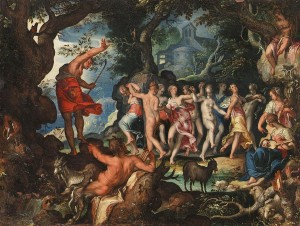
Joachim Wtewael’s The Apulian Shepherd is vibrant and brightly colored mythological painting composed of oil on copper. The piece was produced in the Netherlands during the Baroque period. Wtewael’s The Apulian Shepherd pertains mainly shades of pink, flesh, and neutral tones of brown, yellow and green. Wtewael’s earlier work Venus and Diana consist predominately of pink, flesh and yellow tones, like The Apulian Shepherd.
An Apulian shepherd stumbling upon a centaur and his twelve nymphs, who are dancing and engaged with music around a pond together is being depicted in the piece. The narrative for painting is based on a story from Ovid’s Metamorphoses (14.512-527). Metamorphoses 14.512-527 tells the story of a shepherd who stumbles upon Pan, the Greek God of shepherds and flocks, of mountain wilds, hunting and rustic music, and his nymph companions while in the woods. The moral beyond the mythological story is not to mock the gods personally or their companions, which would be the nymphs in this case.
By Taylor McNeil